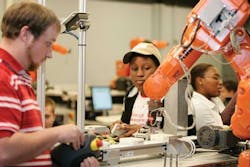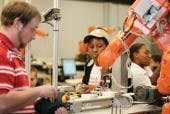ISU Manufacturing Lab Builds Future Engineers
Everybody wants to know where to find the next generation of control and automation engineers, but few folks go seek them, and fewer still provide active support. Certainly, Asia is churning out engineers like a carousel filler, but several U.S. universities are molding and assembling new engineers, too. For instance, one batch of likely recruits can be found in the new Integrated Manufacturing Lab at Illinois State University.
Funded by a $1.2 million grant from the Caterpillar Foundation and support from Bosch Rexroths Linear Motion and Assembly Technologies Group, ISUs manufacturing lab includes a classroom and an integrated automation systems laboratory with a veritable orchestra of components to give students hands-on experience in applications that address todays major manufacturing trends, such as flexible manufacturing of small batch and custom orders, coupled with data collection.
Hands-On, In-Lab Learning
Students at Illinois State Universitys Integrated Manufacturing Lab connect individual workstations to integrate complete, multi-step, assembly tasks.
In nearly every assembly line we visited, we found Bosch Rexroths aluminum structural framing and conveyor components being used to construct the workstations and assembly lines, says Kennell. As a result, the firms Linear Motion and Assembly representatives, Tony Babich and Bashar Abdo, worked with Devine and Kennell to design the labs workstations and conveyors, and they selected Rexroths linear motion components for the lab.
Up and Running and Teaching
ISUs resulting classroom/lab combination provides instruction in fluid and mechanical power systems, analog and digital electronics, programmable logic control, and other manufacturing-based computer applications. The lab contains 10 identical workstations, each using Rexroths framing, which allows students to build fixtures using simple brackets, bolt-together fasteners, and other aluminum accessories on a slotted tabletop. Students also can change configurations, so they can mount new components, electronic sensors, and other devices without special tools or training.
At each workstation, students have access to a PLC, an ABB robot, conveyor with variable frequency drive, vision system, radio frequency identification (RFID) components, human-machine interface (HMI), sensors, DeviceNet and Ethernet-IP networks, and a personal computer. Also, two of Rexroths VarioFlow modular chain conveyors enable students to link workstations, and integrate entire multi-step assembly systems.
Manufacturers need more advanced knowledge from our students, so they must learn to integrate a variety of technical systems, adds Kennell. The demand is for students capable of working with multiple automation components and systems for mass production, as well as for the increasingly important small-batch and custom demands. We combined all of these options plus the capacity to introduce data collection applications into our Integrated Manufacturing Lab.
In addition, as part of the curriculum, students learn to work in teams to simulate communication among manufacturing partners, including engineers, upper- and mid-level management, technicians, and end-users. To facilitate this communication, the 10 workstations are linked by the two backbone VarioFlow pallet conveyor systems. Each workstation accommodates two students, and these workstations can be moved and configured to simulate many manufacturing activities, such as machine tending, assembly, inspection, and palletizing. Identical workstations also allow instructors to replicate activities from station to station.
A Sweet Final Exam
To officially dedicate the lab, two classes worked on deadline to prepare a final projectan assembly line that allowed guests to specify different chocolates to be placed in a six-pocketed box. Completed orders from the HMI caused boxes to be loaded onto a VarioFlow conveyor pallet for which an RFID tag was written. Each tag contained the personalized recipe for its particular box, which were placed on each pallet, and then filled according to the order. Student-written programs ran the robots tooling, and they designed and built the whole system.
The lab and projects like the chocolate boxes immerse students in a genuine manufacturing scenario where they must perform under real-time constraints, says Kennell. Products like the chain conveyor and aluminum framing give them the freedom and versatility to configure the workstations and assembly line as needed, use the conveyor to integrate each step, and set up all the equipment on their own.



